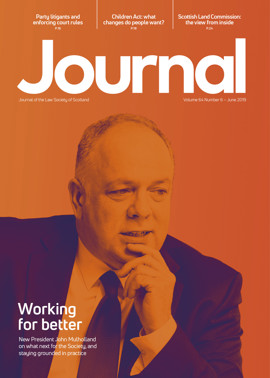Children Act: the results are in

Between May and September 2018, the Scottish Government ran a wide ranging public consultation on potential changes to part 1 of the Children (Scotland) Act 1995. My earlier article (Journal, June 2018, 22) discussed the key points covered. The Act very much remains good law, but in the 24 years since it was passed, Scotland has seen many societal changes. The landscape of how families are created, the roles played by parents, and the movement of families have changed dramatically. We recognise the lifelong impact of adverse childhood experiences, including high-conflict court cases, on children.
A report was published on 22 May 2019 analysing the key responses in relation to each of the areas consulted on. A total of 549 substantive responses were received, 254 to the main consultation and 295 to a survey issued to young people. This article will consider some of the areas with the most responses (positive and negative) to the main paper, and how these views might be reflected in legal reform.
The 254 responses included 171 individuals and 83 organisations, local authorities making up the highest percentage of the latter. The legal profession submitted 13% of responses.
Relationships with children after separation
Fifty per cent of respondents agreed that there should be a presumption in law that a child benefits from both parents being involved in their life. (The mirror question, whether there should be no such presumption, obtained a 52% negative response.) And 50% disagreed with the term “parental rights” being removed from the 1995 Act entirely.
This is an aspect of resolving parental conflict which practitioners tackle every day. We now have the benefit of research supporting the hypothesis that shared care does produce tangible benefits for children. Would including this as a presumption in law make a practical difference to how s 11 cases are litigated? Across the board, respondents prioritised the importance of both parents being involved in a child’s life, unless there was good reason otherwise. It would certainly allow both parents to feel that they were litigating on an even playing field and ensure that, when making decisions that go against the presumption, reasons are given as to why.
Following on from this, 56% agreed that the Government should take action to try to stop a child being put under pressure by one parent to reject the other. Precisely what this action would be is unclear. Research tells us that the pressure involved can be unintended or unconscious – but no doubt practitioners would welcome guidance on disputes where the spectre of parental alienation is in play. Raising awareness of the negative impact of this type of pressure on a child, in its own right an adverse childhood experience which can cause significant problems in later life for mental and physical wellbeing, is perhaps a way to educate parents about the longlasting repercussions of imposing their disputes on their children.
The most popular “yes” response was to the question about clarifying the 1995 Act so that siblings, including those under 16, can apply for contact without parental rights and responsibilities. This would entail relatively minor amendment; however a knock-on effect is likely to be the increased number of legal aid applications from siblings. Practitioners already encounter difficulty in obtaining legal aid for parents, and it is suggested that further investment in civil legal aid is necessary, together with guidance from the Scottish Legal Aid Board to ensure this would not be a hollow amendment.
There was a fairly even split as regards grandparents’ rights: 45% favoured a presumption that children benefit from contact with their grandparents, while 40% considered there should be no such presumption. This could easily be provided for by the best interests test.
The fact that such a significant number felt strongly about each of these points shows there is still work to do in adapting the law to reflect the struggles which children, parents, courts and practitioners are dealing with on a daily basis.
Domestic abuse
Here, 51% considered that the Act should be amended to enable directions to protect abuse victims and other vulnerable parties in hearings arising under s 11 applications.
This, if implemented, would be a useful provision allowing sheriffs and practitioners on a case-by-case basis to assess how best to tailor s 11 hearings to allow all parties to feel safe and able to participate in the process effectively. In practice, these issues are dealt with ad hoc and the approach tends to vary by sheriffdom, sheriff and practitioner.
In addition, half of the respondents agreed that action should be taken to ensure civil courts have information on domestic abuse when considering a case under s 11, and that the Government should explore ways to improve interaction between criminal and civil courts where domestic abuse has been alleged.
In s 11 cases, domestic abuse is often raised in the pleadings. If there are documented incidents that have led to prosecution, the transmission of information should be fairly straightforward and is often accomplished already by a child welfare reporter obtaining a schedule of previous convictions. The nature of domestic abuse, however, means that victims often do not report incidents and there is no record. The introduction for example of an assessment which could operate in similar terms to the appointment of a child welfare reporter would be useful.
Contact centres
The question “Should child contact centres be regulated?” gathered a 66% “yes” response. Only 6% felt there was no requirement to regulate contact centres.
Contact centres handle very challenging situations and work with vulnerable children, therefore some form of regulation is important and appropriate. In particular, respondents sought training in children’s rights, domestic abuse, parental alienation, trauma, attachment and child protection. Importantly, a number confirmed that the regulation they desired could only happen with appropriate investment from the Government.
The ever-growing use of child contact centres brings with it a requirement for transparency, regulation and training. This ensures consistency for the families and children who use them.
Court procedure
On the question of contact, 54% agreed that primary legislation should specify that any delay in a case relating to the upbringing of a child is likely to affect the child’s welfare.
Practitioners have long been aware of the requirement to resolve issues involving children expeditiously. That has in no small way been assisted by the introduction of case management. A balance, however, has to be struck against situations where information is required or matters take place that require further investigation. It is likely that the introduction of such a provision would not substantively change practice. Sixty per cent agreed that the Government should provide guidance for litigants and children in relation to contact and residence. Glasgow Sheriff Court already produces a very helpful handout to parents, explaining what the court expects in a contact dispute.
Official guidance in relation to procedure and to how the court system makes decisions would only be beneficial, and would help children who are of an age to understand the guidance make sense of the proceedings, which very often involve their parents with little to no input from them other than giving their views to a child welfare reporter.
Child welfare reporters/children’s views
Other aspects of the consultation provided less clear-cut answers.
There was no clear consensus on whether the presumption that a child aged 12 or over is of sufficient age or maturity to form a view should be removed from the Act.
Regarding the best way to obtain children’s views, the majority made no response, with a fairly even split between continuing to use form F9, child welfare reporters, the child speaking directly with the judge or sheriff, child support workers or another unspecified way. This supports the general proposition that the way children’s views are currently taken, with a wide discretion in the court, continues to work well and no one approach is better than another.
There has been a suggestion that there should be a consultation and/or practice note on the appointment of child welfare reporters, and the form and standards expected in relation to reports, in order to tackle perceived inconsistencies in appointments and quality of reports around the country. Some jurisdictions are currently refusing to accept applications to join the list of reporters pending the outcome of the consultation, while others are still making appointments.
Enforcing contact orders
Only 9% of respondents felt that there should be no change to existing procedures. The largest “yes” answer, at 29%, was making the breach of a contact order a criminal offence, with penalties including non-custodial sentences and unpaid work, but that compares with 24% who made no response. There is a clear feeling that the current system is not sufficient in deterring or dealing with breaches of contact orders.
Compulsory DNA testing
Compulsory DNA testing in parentage disputes was supported by 46%, with 19% saying “no” and 35% not answering. A recent ECHR decision concluded that compulsory testing was not a breach of Convention rights so long as certain safeguards were in place.
Conclusion
In conclusion, there are not necessarily any particular surprises in the responses collated.
The proposed changes which have most support are those which reflect our modern society, those which give more autonomy to children in disputes and protection to vulnerable children and adults.
Interestingly, none of the proposals which had significant support would require much in the way of primary legislation, except for regulation of contact centres which, if they are to continue to be the useful tool which they are to families, will require thought and funding.
This supports the contention that the 1995 Act remains good and workable law and that what is required is a change in focus in certain areas, clarification about the roles each parent has to play in the life of a child and continued reflection on how best to serve our children.
This is a wide-ranging consultation paper with over 14 different points, and the writer would recommend reading the analysis report. We should remain proud of the Act and look to ensure that it is updated to reflect our ever evolving understanding of what works well for children and families in modern life.
Perspectives
Features
Briefings
In practice
- Tradecraft – one solicitor's experience
- Dear employer...
- Team building – for the Foundation?
- Accredited paralegal practice area highlight: conveyancing
- Accredited Paralegal Committee profile
- What's new for paralegals?
- Ask Ash
- Managing the risk of workplace stress
- Appreciation: Iain Alexander Macmillan
- Revealed – by your AML certificates






